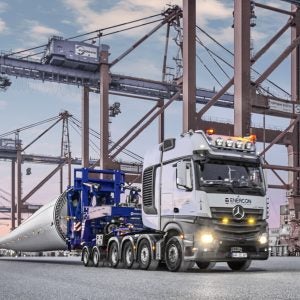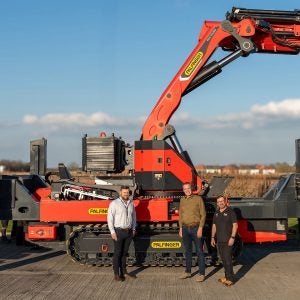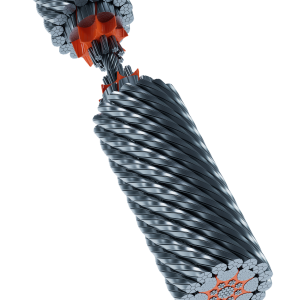There is a new name in crane manufacturing, Dorman Long Xena Cranes, based in Darlington in the UK.
Although the Xena name is new, the company behind it is not. Dorman Long, part of the Cleveland Bridge group since 1982, is a long established engineering company that has built bridges around the world. It is now producing the Xena range of portable cranes from its Darlington base.
The crane is featured on the front cover of the August edition of Cranes Today and it has already proved itself on a bridge construction contract in Ireland.
Technical director Jim Hume explained that Dorman Long had been looking for an alternative solution to a tower crane on the Boyne Bridge that Cleveland Bridge is now building in Ireland. The Xena is being used to lift the temporary cables that hold the deck during the launch. A tower crane, the usual solution, would have been in the way of launching the deck. A winch was considered instead, but a small derrick-type crane was reckoned to be the best solution. Hume looked at Potain’s PC 10 portable crane as well as the Herkules RK 11 made by STC Scan-Tech that has common genesis with the PC 10. He decided that what was available was too small and it was simpler to go about producing a solution in-house.
Lennart Avnby, managing director of Thailand-based STC Scan-Tech, tells it slightly differently. He says that Dorman Long came to Thailand and offered to buy the rights to the Herkules, including the 14 units he has in stock. Faced with a refusal from Avnby, Dorman Long decided to build its own version. Certainly there is a strong link between Xena and Herkules, and not just in the names; Xena’s designer is Michael Thorsfelt, who was previously with STC Scan-Tech.
Avnby admits that business for Herkules cranes has been ‘very quiet’ and says that STC Scan-Tech is focusing more on its offshore and marine cranes, but clearly the purchase offer was not good enough for him. Furthermore, STC Scan-Tech has produced designs for a new, bigger Herkules model, rated at 22tm (see next month’s issue for more details).
The first Xena built by Dorman Long has been on site on Boyne Bridge since May. Called Xena 25 (the manufacturer gives it a 25tm rating), maximum capacity is 10.3t at 1m radius using six falls of wire rope. At 3m it lifts 5.8t and at 10m it lifts 1.7t. Maximum reach is 14m, where it can lift 1.31t. The drum can hold enough wire rope for a maximum height under hook of 200m.
As with the PC 10 and the Herkules, the Xena is designed for doing smaller, highly efficient lifts, assisting tower cranes and replacing mobile cranes at low cost. The crane is flexible for use in confined areas, as booms, outriggers and structure are telescopic, giving access to where other cranes cannot reach. Its main applications are expected to be in high rise building construction as well as in tunnelling and other confined sites. With a height of 2.1m, it can work between floors.
All modules are designed to fit into a standard construction hoist cage, so the modular crane parts can be transported up into a high-rise building for installation on site. The optional fly jib can be used as an erection crane that can hoist loads of up to 500kg. Maximum hoisting speed is 61m/min and an empty hook can be lowered at 264m/min.
Most parts weigh less than 100kg, while the heaviest part, the power pack, weighs almost 500kg. Counterweights are made in 15kg pieces, and can be moved either one by one or together.
The crane has up to five hydraulic functions: hoisting, slewing, luffing, telescoping and travelling (hydraulic crawler tracks are offered as an option).
Hume says that the gross weight of the Xena 25 without tracks is 8t but it is rated at 25tm, compared to the PC 10’s weight of 10t and rated capacity of 15tm. The Xena, therefore, is stronger and more portable than the Potain, he says. This is achieved by having a bigger footprint (5.3m x 5.5m), so the trade off is that it is less compact than the PC 10. With telescoping outriggers, the footprint can be reduced, but then lifting capacity is lost.
Thorsfelt, the designer, says that the key differences between Xena and Herkules are: the Herkules cranes are electrically powered whereas Xena is diesel powered, although a 30kW electric motor is to be offered as an option; the Xena has solenoid valves; and the Xena has, as standard, Hetronic remote control and a Wylie safe load indicator. A final difference is that the Herkules has an operator’s platform whereas Xena does not. To be CE compliant for sale in Europe, it had to be either a full cab or nothing at all, says Thorsfelt.
With the prototype working well on the Boyne Bridge, the first units are scheduled to roll off the production line at the end of October. Jim Hume says that units will only be built to order, but with 10 provisional orders already received, he expects to build this amount before the end of the year In Europe the main route to market will be through sister company Dorman Long Access which will be hiring and selling them. Elsewhere Dorman Long has been talking to Herkules distributors such as Bay Crane of New York City and Stevenson Crane in Chicago. Bay Crane has four Herkules RK 11s in its fleet but also has a close relationship with Dorman Long and Cleveland Bridge, having worked together on various projects including stabilising Ground Zero last year.
Says Bay Crane president Kenny Bernardo: ‘The Herkules have gone okay for us, not spectacularly well, but I like the concept and think the bigger Xena machines will gives us more flexibility. We’re goining to bring one in and see what demand we can generate.’
Dorman Long Xena Cranes plans to build four sizes – 5tm, 15tm, 25tm and 35tm. The Xena 5 will be completely man-portable, so it can be carried up into a building, while the larger models split into larger, but easy to handle sections.
Whether Xena can reverse years of decline in the UK crane manufacturing industry remains to be seen. Neither Herkules nor Potain have sold as many units of their portable cranes as one might have expected. However, for Xena a certain level of demand seems guaranteed. Thorsfelt says that Cleveland Bridge – the company whose roll call of bridges around the world includes Sydney Harbour, Tsing Ma, Jiangyin, Bosphorus, Humber, Dartford, Severn and Forth – now plans to use Xena cranes on every suspension bridge and cable stay bridge that it builds.






